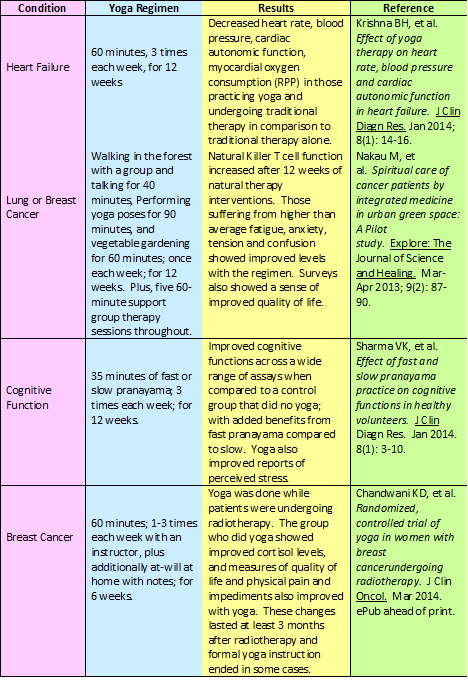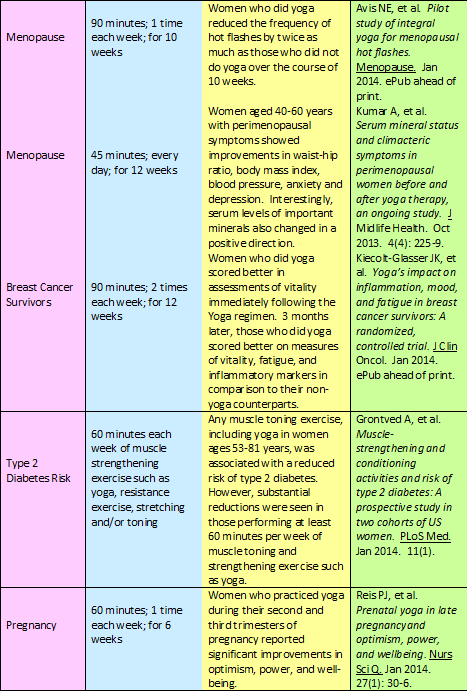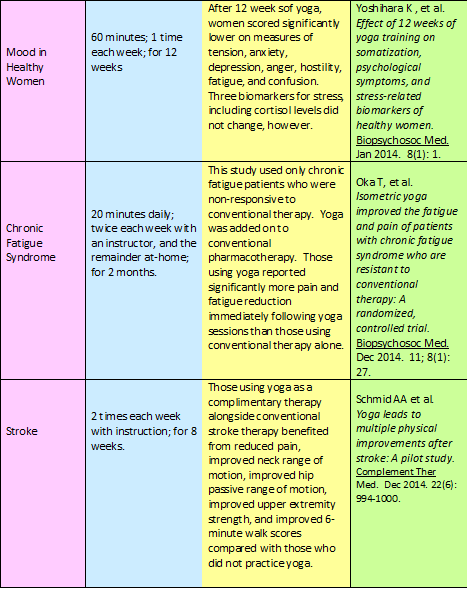Yoga has become a workout sensation over the years, and many wonder if advertised yoga health benefits have any scientific validation. Here, I review the health benefits of yoga that have scientific support, especially how yoga helps women. But yoga isn’t just for women – everything from yoga for cardiovascular disease, to yoga for pregnant women is reviewed here.




Additional Yoga Health Benefits
The term yoga has its roots in an ancient spiritual practice that originated sometime in the 6th or 5th centuries BC. There are multiple forms of yoga with different derivations and intentions for the practice. All ancient yoga practices seemed to have a goal towards both spiritual and physical improvements for those who practice it. These days you can find almost any form of yoga at neighborhood yoga studios and gyms. For that reason, research on the subject has been difficult given the variety of yoga practices. Yoga is a complex activity that can increase heart rate and burn calories – similar to other low-impact exercises – but yoga often also includes stretching, and meditation which are harder to quantify, but almost certainly contribute to yoga’s health benefits.

Yoga for Women
Yoga health benefits for women include improving mood in healthy women and reducing anxiety, depression, anxiety, tension, confusion, and hostility.
Based on the studies listed above and others, it’s not surprising that another German study of post-menopausal women revealed that 79% of women ranked using yoga as effective for their menopausal symptoms (2).
Yoga for pregnant women has garnered a lot of support as a low-cost and low-risk intervention with specific health benefits to the mother and baby. For example, research shows that yoga can improve a woman’s sense of optimism, power and wellbeing. In addition, a biomedical review of the research on yoga for pregnant women that was just released states:
“The findings consistently indicate that yoga intervention presented with lower incidences of prenatal disorders (p ≤ 0.05), and small gestational age (p < 0.05), lower levels of pain and stress (p < 0.05), and higher score of relationship (p < 0.05). In addition, yoga can be safely used for pregnant women who are depressed, at high-risk, or experience lumbopelvic pain. Moreover, yoga is a more effective exercise than walking or standard prenatal exercises.” (6) [emphasis is mine].
The authors go on to recommend additional studies for more detailed results, but folks, I can’t imagine a better biomedical endorsement of yoga for pregnant women.
Yoga for Cardiovascular Disease
Researchers have also looked at yoga health benefits for cardiovascular disease and have found that following a diagnosis of heart failure, a yoga regimen had the following benefits:
· Decreased heart rate
· Decreased blood pressure
· Decreased cardiac autonomic function
· Decreased myocardial oxygen consumption
· Improved body-mass index (7)
· Improved systolic blood pressure (7)
· Improved LDL cholesterol (7)
· Improved HDL cholesterol (7)
One review of yoga and cardiovascular disease sums it up: “in view of the existing knowledge and yoga being a cost-effective technique without side effects, it appears appropriate to incorporate yoga/meditation for primary and secondary prevention of cardiovascular disease” (5). That is quite an endorsement from the biomedical community.
But wait! That’s not all…
Yoga for Back Pain
One study found that 14.3% of women surveyed with back pain between the ages of 60-65 years old were using yoga as a means to improve the condition (1). And still another review concluded that yoga is effective in the management of persistent neck pain, based on several studies (4). These studies, and many anecdotal stories suggest that yoga health benefits extend to aches and pains.
Yoga for IBS
Still other reviews this year cited the potential yoga health benefits for Irritable Bowel Syndrome (IBS) and the quality of life complaints associated with IBS medications (3).
So how about you? Do you practice yoga? What yoga health benefits have you seen? Will yoga be part of your New Year’s Resolution? I’d love to hear from you below…
Wishing you all the simple things,
Zara
Additional References:
1. Murthy V, et al. Self-prescribed complementary and alternative medicine use for back pain amongst a range of care options: Results from a nationally representative sample of 1310 women aged 60-65 years. Compliment Ther Med. Feb 2014. 22(1): 133-40.
2. Buhling KG, et al. The use of complimentary and alternative medicine by women transitioning through menopause in Germany: Results of a survey of women aged 45-60 years. Complement Ther Med. Feb 2014. 22(1): 94-8.
3. Grundman O, et al. Complimentary and alternative medicines in irritable bowel syndrome: An integrative view. World J Gastroenterol. Jan 2014. 20(2): 346-62.
4. Basch DS, et al. Is exercise effective for the management of neck pain and associated disorders or whiplash-associated disorders? A systematic review by the Ontario Protocol for Traffic Injury Management (OPTIMa) Collaboration. Spine J. Feb 2014. Epub ahead of print.
5. Manchanda SC, et al. Yoga and meditation in cardiovascular disease. Clin Res Cardiol. Jan 2014. ePub ahead of print.
6. Jiang Q, et al. Effects of yoga intervention during pregnancy: A review for current status. Am J Perinatol. 23 Dec 2014. ePub ahead of print.
7. Chu P, et al. The effectiveness of yoga in modifying risk factors for cardiovascular disease and metabolic syndrome: A systematic review and meta-analysis of randomized controlled trials. Eur J Prev Cardiol. 14 Dec 2014. ePub ahead of print.
This article was originally published at www.scienceofnaturalhealth.com and has been reprinted here with permission from the author.
toto togel
situs toto
situs togel
data macau
prediksi hk
prediksi sdy
toto slot
situs toto
toto slot
situs toto
situs toto
toto slot
pam4d
situs togel
gimbal4d
pam4d
pam4d
gimbal4d
sangkarbet
sangkarbet
gimbal4d
togel online
situs toto
toto slot
situs toto
toto slot
bandar togel
situs toto
toto slot
slot thailand
pafikotatambrauw.org
pafikotapegununganbintang.org
pafikotamimika.org
pafikotamamujutengah.org
pafikotamalukutenggara.org
pafikotabovendigoel.org
pafikotamalukutengah.org
pafikotalannyjaya.org
pafikotakepulauanyapen.org
pafikotaintanjaya.org
pafikotaburuselatan.org
pafikotabiaknumfor.org

